For the 2025 school year, there is 1 public elementary school serving 417 students in Marysville School District. This district's average elementary testing ranking is 7/10, which is in the top 50% of public elementary schools in Kansas.
Public Elementary School in Marysville School District have an average math proficiency score of 42% (versus the Kansas public elementary school average of 32%), and reading proficiency score of 32% (versus the 34% statewide average).
Minority enrollment is 19% of the student body (majority Hispanic), which is less than the Kansas public elementary school average of 39% (majority Hispanic).
Overview
This School District
This State (KS)
# Schools
2 Schools
991 Schools
# Students
785 Students
319,724 Students
# Teachers
66 Teachers
22,707 Teachers
Student : Teacher Ratio
12:1
12:1
District Rank
Marysville School District, which is ranked within the bottom 50% of all 286 school districts in Kansas (based off of combined math and reading proficiency testing data) for the 2021-2022 school year.
The school district's graduation rate of 90% has stayed relatively flat over five school years.
Overall District Rank
#227 out of 286 school districts
(Bottom 50%)
(Bottom 50%)
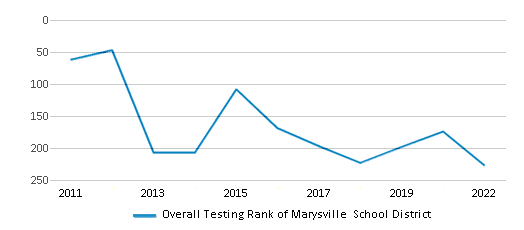
Math Test Scores (% Proficient)
25%
29%

Reading/Language Arts Test Scores (% Proficient)
25%
32%
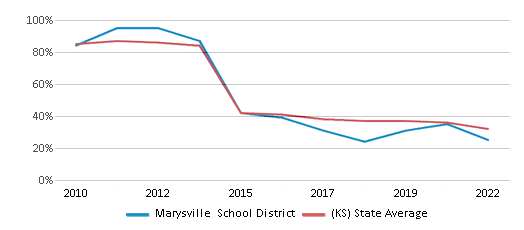
Science Test Scores (% Proficient)
30-34%
31%
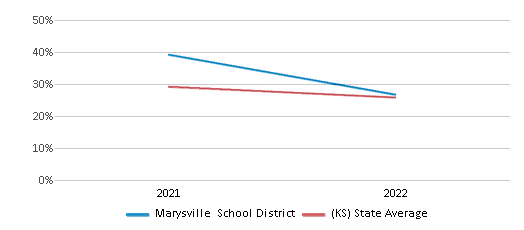
Graduation Rate
≥90%
89%
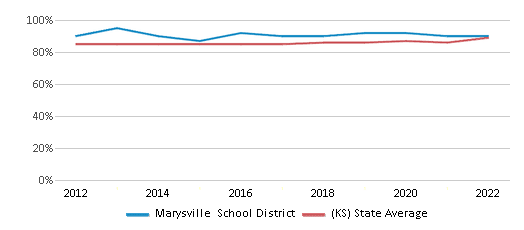
Students by Ethnicity:
Diversity Score
0.25
0.58
# American Indian Students
13 Students
2,385 Students
% American Indian Students
2%
1%
# Asian Students
2 Students
9,132 Students
% Asian Students
n/a
3%
# Hispanic Students
46 Students
70,240 Students
% Hispanic Students
6%
22%
# Black Students
11 Students
20,732 Students
% Black Students
1%
6%
# White Students
677 Students
195,194 Students
% White Students
86%
61%
# Hawaiian Students
n/a
819 Students
% Hawaiian Students
n/a
n/a
# Two or more races Students
36 Students
21,222 Students
% of Two or more races Students
5%
7%
Students by Grade:
# Students in PK Grade:
57
21,555
# Students in K Grade:
50
31,361
# Students in 1st Grade:
53
32,919
# Students in 2nd Grade:
50
34,119
# Students in 3rd Grade:
51
33,302
# Students in 4th Grade:
53
34,287
# Students in 5th Grade:
47
34,416
# Students in 6th Grade:
56
35,078
# Students in 7th Grade:
54
26,471
# Students in 8th Grade:
65
27,204
# Students in 9th Grade:
64
1,831
# Students in 10th Grade:
71
2,103
# Students in 11th Grade:
57
2,243
# Students in 12th Grade:
57
2,247
# Ungraded Students:
-
588
District Revenue and Spending
The revenue/student of $21,688 is higher than the state median of $16,276. The school district revenue/student has grown by 5% over four school years.
The school district's spending/student of $24,089 is higher than the state median of $17,192. The school district spending/student has grown by 5% over four school years.
Total Revenue
$17 MM
$7,774 MM
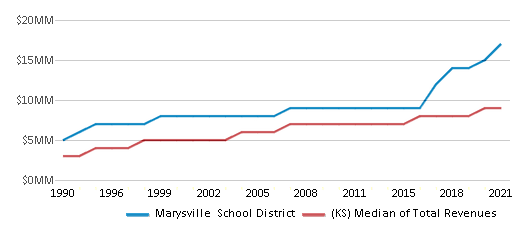
Spending
$19 MM
$8,211 MM
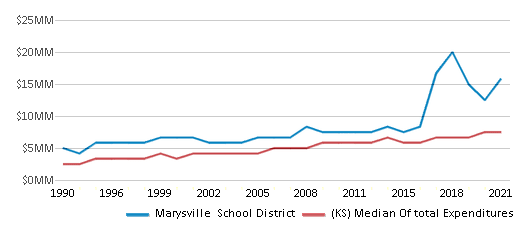
Revenue / Student
$21,688
$16,276
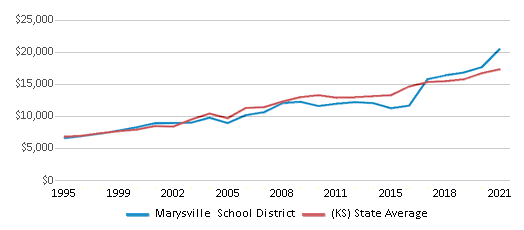
Spending / Student
$24,089
$17,192

Best Marysville School District Public Elementary Schools (2025)
School
(Math and Reading Proficiency)
(Math and Reading Proficiency)
Location
Grades
Students
Rank: #11.
Marysville Elementary School
(Math: 40-44% | Reading: 30-34%)
Rank:
Rank:
7/
Top 50%10
1010 Carolina
Marysville, KS 66508
(785) 562-3641
Marysville, KS 66508
(785) 562-3641
Grades: PK-6
| 417 students
Recent Articles

Year-Round Or Traditional Schedule?
Which is more appropriate for your child? A year-round attendance schedule or traditional schedule? We look at the pros and cons.

Why You Should Encourage Your Child to Join a Sports Team
Participating in team sports has a great many benefits for children, there is no doubt. In this article you will learn what those benefits are.

White Students are Now the Minority in U.S. Public Schools
Increasing birth rates among immigrant families from Asia and Central and South America, combined with lower birth rates among white families, means that for the first time in history, public school students in the United States are majority-minority. This shift in demographics poses difficulties for schools as they work to accommodate children of varying language abilities and socio-economic backgrounds.





